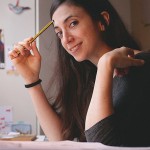Barcelona’s traditions as well as its prestigious schools and university centres make it an attractive location for designers. Modernity attracts modernity, although the business apparatus must be able to consolidate them. A combination of insecurity and incentives is leading to the redefinition of the profession, as shown by Alex Trochut, Marta Altés and Ariadna Serrahima.
- Alex Trochut ©Isa Virtual
- Marta Altés ©Núria Rius
- Ariadna Serrahima ©Albert Armengol
“What I want to be is an active agent,” asserts Ariadna Serrahima (Barcelona, 1984), and nothing seems to define her better than action and collaboration. Having finished her studies at Central Saint Martins in London, she had a brief stay in New York and came back to Barcelona seven years ago. Here, her career took off, taking a specific and divergent direction and founding itself on two pillars: artistic activity associated with the most advanced contemporary creation, and the push for collaborative projects, developed from a perspective of criticism and activism. Serrahima applied to bring out a publication as part of the Catalan Regional Government’s Sala d’Art Jove [Young Art Gallery], but ended up doing an exhibition there instead. In the current boom in artistic formats – where the communicative and narrative dimension is often fundamental – graphic design, understood as a semiotic contribution, is playing a key role.
Ariadna Serrahima is a surge of materialised enthusiasm and projects. The value of the collective is essential in the new work strategies for all kinds of creators and critical agents in a commoditised environment. It is something learned and a model: “You have to be quick and know how to adapt to work collectively”. Serrahima is one of the founders of the cultural association L’Automàtica (www.lautomatica.org), a letterpress printer that uses traditional machines (precious Heidelbergs and Minervas) that was condemned for closure but recovered in 2011 thanks to a group of young people who manage it and have added it to the printer they already had, following an established tradition. This venture coincided with the anti-austerity movement that started in May 2011 and activist involvement that takes shape graphically through Dinou (www.dinou.net), “an irregular publication” that informs and excites with great simplicity. L’Automàtica is also responsible for the growth of Munt (www.munt.net), an experimental music publisher.
Ariadna Serrahima demonstrates how the new generation has a relationship devoid of prejudices regarding the traditional craft and analogy. There is a move away from professionals in studios, closer to a field of production that allows for decision-making and total control over work. She has done numerous designs for other artists’ catalogues and books, although in parallel she is constantly doing her own experimental work, with publications where she crosses techniques and tries out poetic photography bridging noise and silence. It should therefore come as no surprise that she is also dipping her toe into publishing with a personal project, IF Publicacions (www.if-publicacions.org).
Contemporary fables
One of the areas where paper books seem to be thriving is in the children’s genre. We have seen the growth of sections dedicated to this in large bookshops, among the works on art or philosophy. The Flic children and youth literature and arts festival (www.flicfestival.com) is already in its sixth edition. The success of books by Marta Altés (Barcelona, 1982) is an excellent example of this growth and this phenomenon. She studied at EINA University Art and Design Centre and at the Cambridge School of Arts, and has lived in London since 2011, focusing her work on illustrated children’s literature, while still maintaining professional links with Barcelona. She writes and illustrates her books, published by Macmillan and by the innovative publisher Blackie Books in Spain. They have been translated into a number of languages, which may be seen as a sign of their universal qualities.
Although there is a hugely important tradition in this genre in Catalonia, ranging from Lola Anglada to Pilarin Bayés and Roser Capdevila, Marta Altés’ points of reference seem to be others, perhaps American cartoonist Charles Schulz and, particularly, French illustrator Jean-Jacques Sempé. The simplicity of her stories and clarity of the illustrations are requirements of the genre, and the difficulty of achieving this is often overlooked. The results are contemporary fables that offer a tenderly ironic look at local customs and manners and reflect the concerns and wishes of children today. Disorganised, creative or neurotic, the protagonists – children or humanised animals – express the desire for naturalness and freedom that is sought for children who are emotionally balanced, from a modern perspective, where the intention is not to train them. Rebellion and play are celebrated and asserted in a subtle way. As the protagonist in I Am An Artist says, “I am an artist and I can’t stop creating. Everything inspires me”. This elemental joy, this immediate happiness is conveyed through the illustrations, drawn in solid, light lines. They are friendly and modern, and appealing both to children and their parents, who have to read the books again and again in response to their children’s demands.
A style within divergence and complexity
The name on everyone’s lips is a success story: Alex Trochut (Barcelona, 1981). After studying at Elisava Barcelona School of Design and Engineering and a brief stay in Berlin, he has had a meteoric international career, with phenomenal success. Trochut currently works between New York and Barcelona, but his clients are from all over the world and he is regularly invited to universities and schools.
He looks to maintain the freedom in his work and produce his own style, which are the values for which he is in demand; however, he is not a creator in isolation from the market. Trochut has clients. In Barcelona he has worked for the Damm brewery, for example, in addition to multinationals such as Coca-Cola, Nike and British Airways. He designed the cover for the Rolling Stones album Rolled Gold +, where his ribboned letters fit in perfectly with the album’s title as well as the group itself. In 2011 he published More is More, a book that includes work, influences, points of reference and inspirations, which show and demonstrate the qualities of graphic designers today, in the hypervisual Internet culture. Trochut has to fight against his fame, and at the moment it looks like it is going pretty well for him.
It is often said that Alex Trochut is a designer, a draughtsman, baroque. Maybe what is baroque is the era. In any case, his minimalism and elegance are now a rather conservative commonplace. The only intelligent output that is truly linked to contemporary sensibility is eclecticism. Trochut has found a style within divergence and complexity and that differentiates the artist and his discourse from puritan consistency. Despite often working on commission – or maybe for that very reason – graphic designers can end up being more free and provocative than artists.
Trochut is characterised by his meandering, sinuous (undulating) and gnarled (articulated) script, which is labyrinthine like the internet and complex like virtual reality. His poetry or manner is also identified by splatters, liquid script or stains, which are organic but also often have a clean, artificial look. There is something of Pollock’s drip technique, of the seductive shine of Pop Art (especially reminiscent of Ed Ruscha). There is something of graffiti and urban art in his style and, at the same time, a cultured, advertising-like sophistication. Trochut has a style; he has a connection with the craft and with the vibrant ephemeral condition of advertising. He allows us to glimpse the possibility of design beyond fashion and contingency, that touches the spirit of the times.





